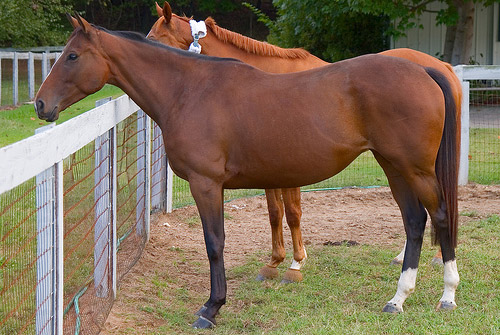
Intro
The first Thoroughbred horse imported to the American colonies was Bulle Rock in 1730. From that point on the colonies began a love affair with horse racing and thoroughbred athletes.
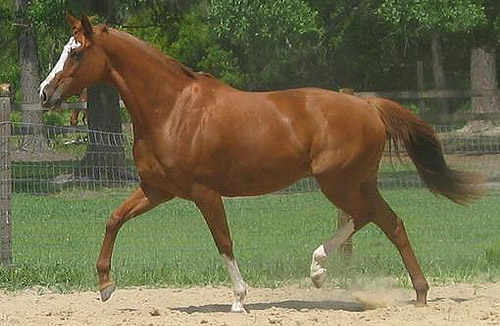
Origins
Originally established during the 17th & 18th century in England, since then the Thoroughbred has been independently developed in several countries.
Upon their arrival in America during the 18th century the colonists quickly developed their own breeding programs. Importing English animals and breeding with existing local stock.
The first native American Thoroughbred to take the track by storm was Sir Archy who was eventually retired from racing for lack of opponents.
Thoroughbreds in the US have also been used to improve other breeds, such as theStandardbred, American Quarter Horses and the Morgan. The Cavalry also used Thoroughbred blood to improve their stock.
Features
Average height 15.2 hands
Fast and active
Brave and built for endurance
Low, flat movement
Fast and active
Brave and built for endurance
Low, flat movement
Physique
Alert, refined head
Long and graceful neck
Long, sloped shoulders
Long, lean body
Strong hindquarters
Legs are fine and long with well-formed joints
Long and graceful neck
Long, sloped shoulders
Long, lean body
Strong hindquarters
Legs are fine and long with well-formed joints
Traditional Colors
Solid colors
Temperament
Bold
Brave
Spirited
Brave
Spirited

Use
Racing
Show horse
Competition horse
Pleasure / trail horse
Show horse
Competition horse
Pleasure / trail horse
Helpful Links
*All links open in a new window
American Thoroughbred Horse
American Thoroughbred Horse
Where To Buy
American Thoroughbred Studs
Video

Intro
This breed actually earns its name, trotters and pacers are required to meet speed requirements prior to registration with the breed. Their name actually comes from the qualifying standard time these animals must pass to qualify for registration (a mile in under 3 minutes).

Origins
This breed was originated by a single English Thoroughbred stallion named Messenger who was brought to America in 1788 and bred to local animals. Every Standardbred can trace their existence to the grandson of this foundation stud. However their bloodlines run across the board, a variety of different (mostly gaited) breeds were introduced in the hopes of creating faster and faster gaited animals.
The official stud book for this breed was formed in 1939.
Two Types
Trotters
Diagonal gait – Legs on opposite sides move at the same time. This is a natural gait, however it is harder to keep a trotter on their stride at high speeds.
Diagonal gait – Legs on opposite sides move at the same time. This is a natural gait, however it is harder to keep a trotter on their stride at high speeds.
Pacers
Lateral gait – legs on the same side move at the same time. Approximately 80% of harness racers use this gait. The lateral pacing gait is ideal for harness racing.
Lateral gait – legs on the same side move at the same time. Approximately 80% of harness racers use this gait. The lateral pacing gait is ideal for harness racing.
Features
Average height 15.2 – 16 hands
Resembles a heavy Thoroughbred in confirmation
Resembles a heavy Thoroughbred in confirmation
Physique
Head is large and may have convex profile
Neck is medium length
Shoulders are powerful
Hindquarters are muscular and strong
legs are solid and refined
Neck is medium length
Shoulders are powerful
Hindquarters are muscular and strong
legs are solid and refined
Traditional Colors
Any solid color
Temperament
Calm and bold
Intelligent
Unflappable
Intelligent
Unflappable
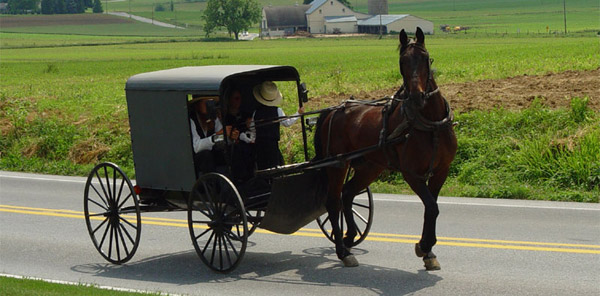
Use
Racing
Show horse
Pleasure horse
Buggy horse
Sport horses
Ranch horse
Show horse
Pleasure horse
Buggy horse
Sport horses
Ranch horse
Helpful Links
*All links open in a new window
US Trotting
Standard Bred
Harness Tracks
US Trotting
Standard Bred
Harness Tracks
Where to Buy
American Standardbred Studs
Video
American Spotted Paso
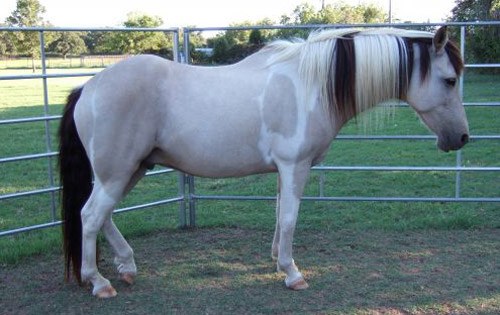
Intro
One of the main goals for the breeders of the American Spotted Paso horse is combining the smooth gaits of the Peruvian Paso horse with the colorful coat patterns of the pinto.
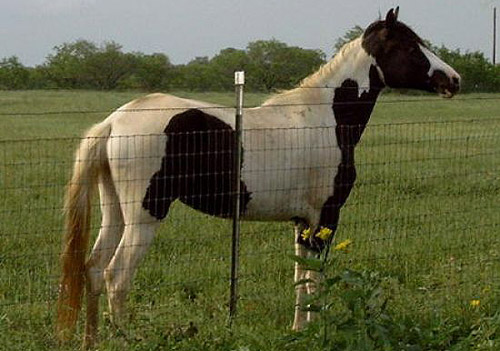
Origins
The breed originated with a pure black Paruvian Paso stallion named Janchovilla who was bred to pinto mares. Of the resulting foals about 3/4 of them were spotted and all of them carried the Paso gait.
There are two different registries for this breed for animals with different degrees of Paso blood. However, to register with either the animal must have one purebred Peruvian Paso and exhibit the four-beat lateral gait.
Features
Move with a four-beat lateral gait
Traditional Colors
Must possess an obvious pinto pattern, tobiano, overo or sabano
Temperament
A kind and willing temperament
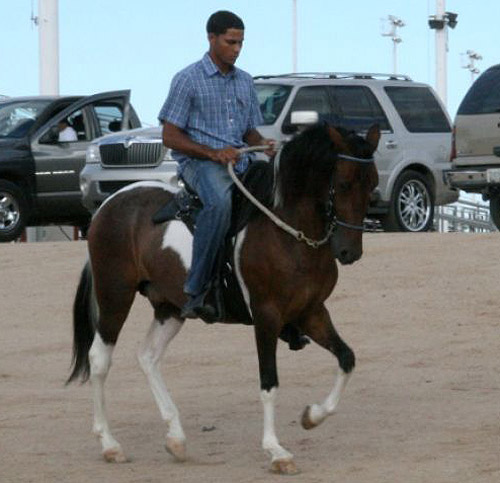
Use
General riding
Trail horse
Endurance horse
Show horse
Therapy horse
Trail horse
Endurance horse
Show horse
Therapy horse
Helpful Links
*All links open in a new window
American Spotted Paso Registry
American Spotted Paso Facts
American Spotted Paso Registry
American Spotted Paso Facts
American Sport Pony
Intro
Sport ponies have been enjoyed for hundreds of years in Europe and their stock gradually made it’s way to North America.
Origins
Through the years, American’s started their own breeding programs to further enhance and promote the sport pony.
In 1981 a North American Sport Pony Registry was initially founded as a division of the American Warmblood Registry. However by 1997 the number and quality of the ponies being produced in America was large enough to warrant their own separate registry.
These ponies are notable because they look and move like small horses and do not have physical pony traits. This is a type breed and their registry will accept a number of bloodlines as long as they meet the general requirements.
Features
Average height 13.2 – 14.2 hands
Moves more like a horse than a pony.
Moves more like a horse than a pony.
Physique
Small, regal head with defined jaw
Kind eyes
Short, wide ears
Long, wide and well set neck
Refined, athletic body
Dry limbs with flat knees
Dense medium sized hooves
Kind eyes
Short, wide ears
Long, wide and well set neck
Refined, athletic body
Dry limbs with flat knees
Dense medium sized hooves
Traditional Colors
All colors
Temperament
Good natured and willing
Easy to keep
Courageous & intelligent
Easy to keep
Courageous & intelligent
Use
Eventing
Showing
Pleasure
Showing
Pleasure
Helpful Links
*All links open in a new window
American Sport Pony Registry
Introducing The American Sport Pony
American Sport Pony Registry
Introducing The American Sport Pony
Where to Buy
American Sport Pony Studs
Video
American Shetland
Intro
The U.S. loves their ponies and through selective imports and good breeding practices, the American Shetland pony has made a name for itself as a smart and handsome harness pony.
Origins
Breeding centered in the state of Indiana after an influx of ponies were imported from the Scottish Shetland Islands starting in 1885.
The formation of the American Shetland Pony Club in 1888 started the selective breeding process that formed the Shetland Pony of today.
Within 50 years two distinct branches of the American Shetland emerged, the Pony of the Americas and the American Shetland.
Refined over the years, the Shetlands of today hardly resemble the hardy island ponies originally brought to North America from Scotland. Today the breeders have engineered a pony built for light driving and riding use.
Bloodlines were influenced by Hackney pony, Arabian and a small amount ofThoroughbred blood to produce a rather distinct confirmation.
Features
Average height 11.2 hands
Hardy and robust pony roots
A result of controlled breeding
Versatile and useful
Hardy and robust pony roots
A result of controlled breeding
Versatile and useful
Physique
Long head and ears with a straight profile
Notable lack of pony character
Deep chest
Luxurious mane and tail growth
Long hind legs
Notable lack of pony character
Deep chest
Luxurious mane and tail growth
Long hind legs
Traditional Colors
All colors
Temperament
Versatile and easygoing for a pony
Good under saddle
Good competitor
Built for driving
Good under saddle
Good competitor
Built for driving
Use
Hackney pony
Harness sulkies
Hunter/jumper
Show ponies
Harness sulkies
Hunter/jumper
Show ponies
Helpful links
* All links open in a new window
American Shetland Pony Club
American Shetland Pony
American Shetland Pony Club
American Shetland Pony
Where to Buy
American Shetland Studs
Video
American Saddlebred
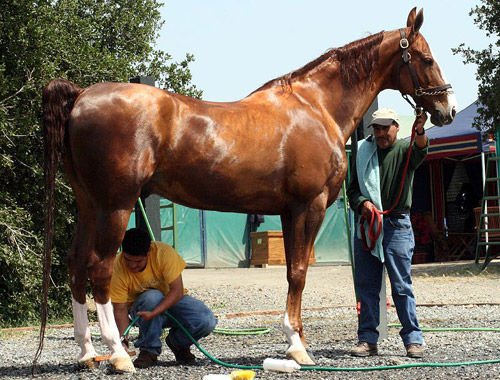
Intro
The American Saddlebred horse played a large part in the development of American history and they gained fame as a breed for their service during the Civil War.
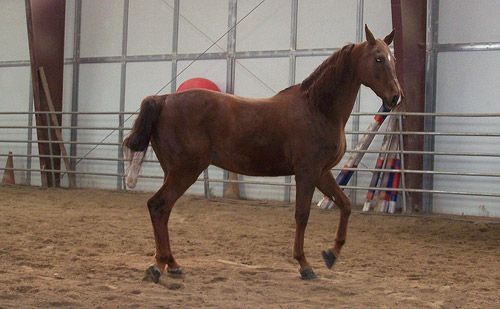
Origins
Also known as the Kentucky Saddler, this breed was developed in Kentucky as a stylish utility horse for gentlemen of the south. They played a large role in the settlement of the upper Ohio Valley and their popularity spread through the south.
Their foundation comes from Morgans, Narragansett Pacers, Canadian Horses, Spanish Horses and trotter stock. Each breed contributing specific characteristics to build a tireless animal that is easy to train and handle.
During the civil war, their tireless service earned them acclaim as a breed. Confederate animals were almost exclusively of American type stock
The American Saddle-Horse Breed Association was formed in 1891 to protect and document the breed.
Features
Average height 15 – 16 hands
Beautiful and stylish
Gaits are easy with a high, true, smooth action
Beautiful and stylish
Gaits are easy with a high, true, smooth action
Physique
Head is finely chiseled with a lean, smooth jaw
Eyes are bright and set wide apart
Ears are sharp and dainty
Neck is medium and arched
Short, strong backs
Compact body with deep girth
Tail is high set, proudly carried and flowing
Clean, flat-boned and very straight legs
Well-formed feet
Eyes are bright and set wide apart
Ears are sharp and dainty
Neck is medium and arched
Short, strong backs
Compact body with deep girth
Tail is high set, proudly carried and flowing
Clean, flat-boned and very straight legs
Well-formed feet
Traditional Colors
Temperament
Even temper
Willing and intelligent
Smart and obedient
Friendly and gentle
Willing and intelligent
Smart and obedient
Friendly and gentle
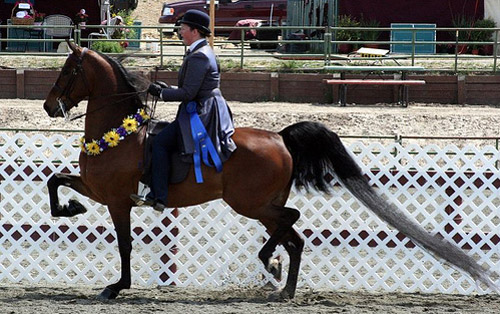
Use
Saddle horses
Show horses
Pleasure riding horses
Work horses
Show horses
Pleasure riding horses
Work horses
Helpful Links
*All links open in a new window
American Saddlebred Horse Association
American Saddlebred
American Saddlebred Horse Association of Canada
American Saddlebred Association UK
American Saddlebred Horse Museum
American Saddlebred Horse Association
American Saddlebred
American Saddlebred Horse Association of Canada
American Saddlebred Association UK
American Saddlebred Horse Museum
Where to Buy
American Saddlebred Studs
Video
American Paint
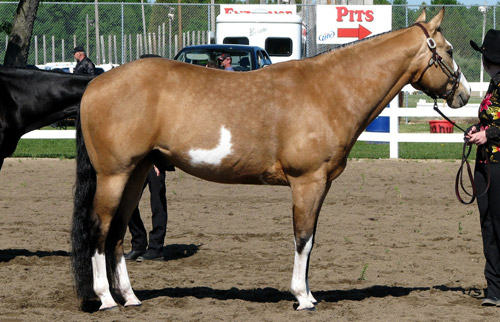
Intro
The paint is a performance type color breed and are bred exclusively to keep their spotted pattern. Crosses to gaited, pony or draft breeds are not recognized by the registry, only Thoroughbred or Quarter Horse blood is allowed.
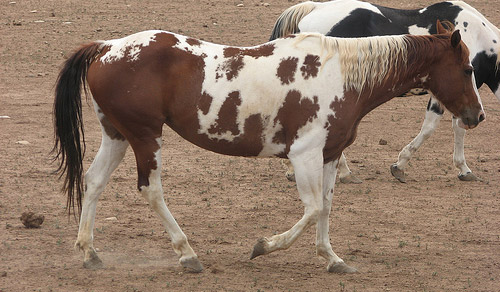
Origins
The first paint horses in American are thought to have been brought over from Spain, where record of their existence stretches back to 700 A.D.
These spotted horses were prized by Native Americans and among the early cow ponies and stock animals of the 18th and 19th centuries.
Today the paint horse is heavily influenced by Thoroughbred and Quarter Horseblood, creating a versatile and intelligent animal. Breeding is based on American Paint Horse Registry (APHA), American Quarter Horse Association and Jockey Club Registry requirements.
Overo
Rarely has white extending across the back between withers and tail
At least one (and often all four) dark legs
Head markings are bald, apron or bonnet-faced
White markings are irregular, scattered and spash-like
Tail is generally one color
Animal may be either predominately white or dark
Rarely has white extending across the back between withers and tail
At least one (and often all four) dark legs
Head markings are bald, apron or bonnet-faced
White markings are irregular, scattered and spash-like
Tail is generally one color
Animal may be either predominately white or dark
Tobiano
Generally displays solid colored head with a facial marking
Usually all four legs are white below hocks and knees
Spots are regular and clear in oval or round patterns
Spots on neck and chest and either one or both flanks are dark
Animal may be either predominately white or dark
Generally displays solid colored head with a facial marking
Usually all four legs are white below hocks and knees
Spots are regular and clear in oval or round patterns
Spots on neck and chest and either one or both flanks are dark
Animal may be either predominately white or dark
Features
Average height 15 – 16 hands
Good balance
Built solid for stock work
Compact and refined
Good balance
Built solid for stock work
Compact and refined
Physique
Head is straight with large eyes
Neck is muscular and well-formed
Sloped shoulder and short, strong back
Legs are solid and strong
Neck is muscular and well-formed
Sloped shoulder and short, strong back
Legs are solid and strong
Traditional Colors
Temperament
Intelligent and refined
Strong and willing animal built for hard work
Refined elements of Thoroughbred and QH blood creates a versatile animal
Strong and willing animal built for hard work
Refined elements of Thoroughbred and QH blood creates a versatile animal
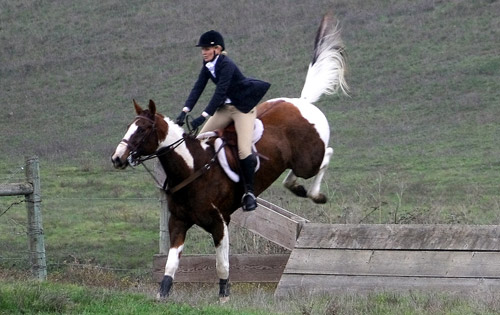
Use
Show horses
Stock horses
Pleasure horses
Stock horses
Pleasure horses
Helpful Links
*All links open in a new window
American Paint Horse Association
APHA World Show
UK Paint Association
Paint Horse Journal
American Paint Horse Association
APHA World Show
UK Paint Association
Paint Horse Journal
Where to Buy
American Paint Horse Studs
Video
Quarter Horse
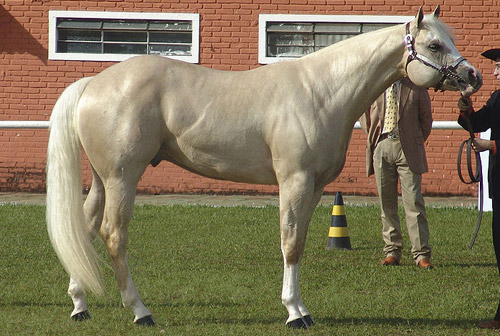
Intro
Especially known for their association with the Cowboys of the wild wild west, the Quarter Horse is a symbol of American Horsemanship, and the oldest North American breed.
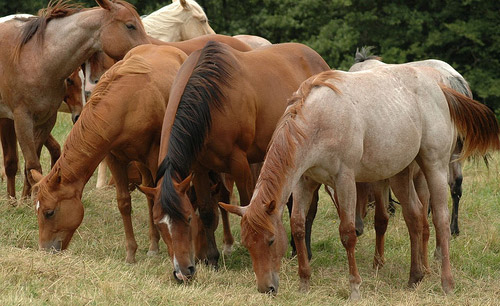
Origins
The breed originated in 17th century colonial Virginia. The horses available to the new settlers there were of mixed Spanish descent, carrying traces of Andalusian, Barb, and Arabian blood.
Early in the 17th century these local horses were crossed with English Thoroughbreds. The result of the tough Spanish stock and the more refined English animals was a squat, stocky animal with large, muscular hindquarters.
Used to help build the west, the Quarter horse is built to haul goods, work cattle, and riding long distances over rough terrain.
Above their versatility, they are prized for their sprinting speed over the quarter mile. The origins of their name, their explosive speed over the quarter mile track make them entertainment too.
Today the Quarter Horse Registry is the largest in the world with over 3 million entries.
Features
Average height 15-5.2 hands
Strong, muscluar hindquarters make them strong sprinters
versatile and eager to please
Strong, muscluar hindquarters make them strong sprinters
versatile and eager to please
Physique
Head is short and wide, with a small muzzle
Underline is longer than the back, gives compact impression
Chunky, muscular hindquarters
Legs are strong, with flat knees
Underline is longer than the back, gives compact impression
Chunky, muscular hindquarters
Legs are strong, with flat knees
Traditional Colors
All colors
Temperament
Eager to please and versatile as they come
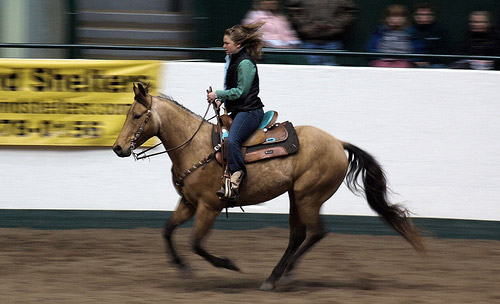
Use
Racing
Pleasure / trail horse
Show horse
Rodeo horse
Cutting horse
Work horse
Pleasure / trail horse
Show horse
Rodeo horse
Cutting horse
Work horse
Helpful Links
*All links open in a new window
American Quarter Horse Association
National Foundation Quarter Horse Association
Foundationhorses.com
Texas Quarter Horse Association
Pacific Coast Quarter Horse Association
American Quarter Horse Association
National Foundation Quarter Horse Association
Foundationhorses.com
Texas Quarter Horse Association
Pacific Coast Quarter Horse Association
Where to Buy
WIldcat Quarter Horses
Circle P Ranch
Thehorsesource.com
Quarter Horse Directory
Quarterhorsesforsale.com
Circle P Ranch
Thehorsesource.com
Quarter Horse Directory
Quarterhorsesforsale.com
Quarter Horse Studs
Video
American Mustang
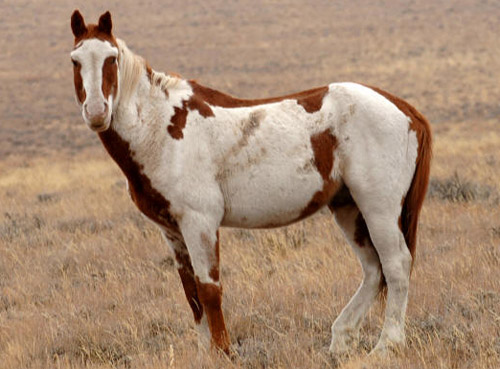
Intro
The American mustang symbolizes the freedom of the wild west in North America. The word mustang comes from the Spanish word mestena which is roughly translated as a group of wild horses.

Origins
The Mustang is a descendant of Spanish horses introduced in the 16th century by Spanish conquistadores. These imported horses formed wild herds after the Spanish conquests, and continued to reproduce with local animals. Their bloodlines carry Barb, Jennet and Andalusian influence.
The American Mustang Association (AMA) was formed in 1962 in San Diego, CA to preserve and document the pedigrees of American Mustang horses.
Horses are registered to meet morphological standards and measurements in the hopes of preserving the characteristics of the original Spanish animals.
The specific physical attributes of registered animals are distinct and the animals cannot be registered under another breeds registry.
Features
Average height 13.2 – 15 hands
Being descendant from the Barb means that a true mustang should have 17 ribs and 5 lumbar vertebrae.
Symmetrical, smooth muscled and well proportioned
Being descendant from the Barb means that a true mustang should have 17 ribs and 5 lumbar vertebrae.
Symmetrical, smooth muscled and well proportioned
Physique
Head is refined with a tapering muzzle & carried high and proud
Neck is crested and high set
Shoulder is long and sloping
Back is short and hindquarters are muscular
Deep girth
Low set tail
Legs straight and sound without coarseness
Hooves are wide at the base and dense
Neck is crested and high set
Shoulder is long and sloping
Back is short and hindquarters are muscular
Deep girth
Low set tail
Legs straight and sound without coarseness
Hooves are wide at the base and dense
Traditional Colors:
Can be any color due to bloodline dilution, although more traditional Spanish horse coloring is valued.
roan | dun | buckskin
roan | dun | buckskin
Temperament
The mustang is a wild animal
Stubborn tendencies
Highly spirited
Full of vigor
Stubborn tendencies
Highly spirited
Full of vigor
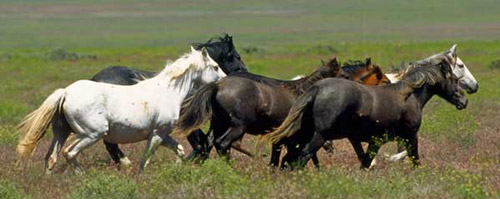
Use
General riding
Cow horse
Trail horse
Carriage horse
Cow horse
Trail horse
Carriage horse
Helpful Links
* All links open in a new window
American Mustang and Burrow Association
American Mustang and Burrow Association
Where to Buy
Mustang Studs
Video
American Miniature
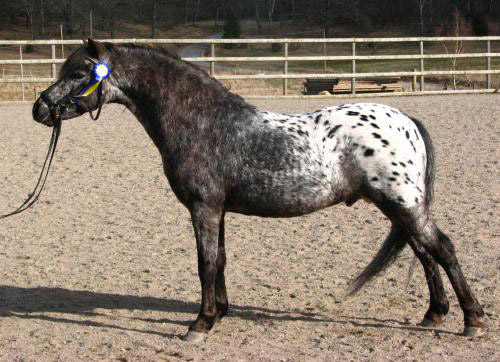
Image from extrasida
Intro
Miniature horses come from English and Dutch mine horses that were imported to the Americas in the 19th century for use in coal mines in the Appalachian mountains.
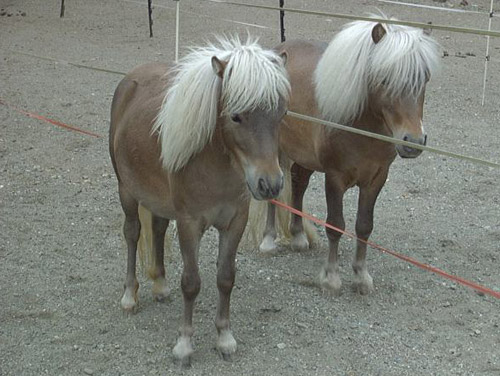
Image from Lucky Diamond Ranch
Origins
Their bloodlines draw from many sources, initially it was mainly Shetland and Dartmoor stock, and later the Americans crossed them with Hackney, POA andThoroughbred blood for refinement and size.
In 1978 the American Miniature Horse Association was formed to protect and document the American Miniature horses as a distinct breed. Only animals within the required size guidelines and proper confirmation were allowed to be registered.
There are two types recognized by the registry
Division A Miniatures
Up to 34″ in height at the withers
Up to 34″ in height at the withers
Division B Miniatures
Between 34″ and 38″ in height at the withers
Between 34″ and 38″ in height at the withers
Features
Average height – up to 38″
Agile and strong
Agile and strong
Physique
Due to the different bloodlines there are several different types of American Miniatures. The main two are Arabian and Draft.
Physical characteristics will vary, animals are registered based on height and well-proportioned confirmation.
Physical characteristics will vary, animals are registered based on height and well-proportioned confirmation.
Traditional Colors
All colors
Temperament
Alert and intelligent
Thrive on attention
Curious and playful
Thrive on attention
Curious and playful
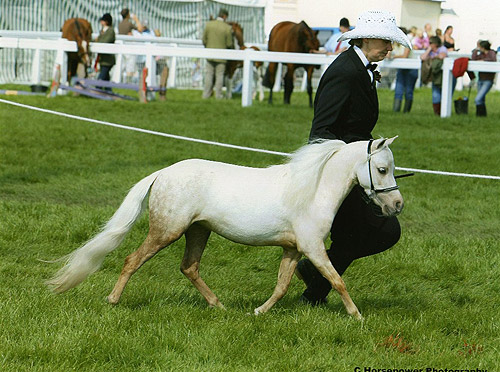
Image from Donabi Miniatures
Use
Pet
Show horse
Riding horse
Driving or cart horse
Therapy animals
Show horse
Riding horse
Driving or cart horse
Therapy animals
Helpful Links
*All links open in a new window
American Miniature Horse Association
American Shetland Pony Club
The Miniature Horse
Shetland Miniature
One Stop Equine
Mini Horse
American Shetland Pony Club
The Miniature Horse
Shetland Miniature
One Stop Equine
Mini Horse
Where to Buy
American Miniature Horse
American Miniature Horses
Donabi Miniatures
American Miniature Horses UK
Unicorner Farm
American Miniature Horses
Donabi Miniatures
American Miniature Horses UK
Unicorner Farm
American Miniature Studs
Video
American Mammoth Jack
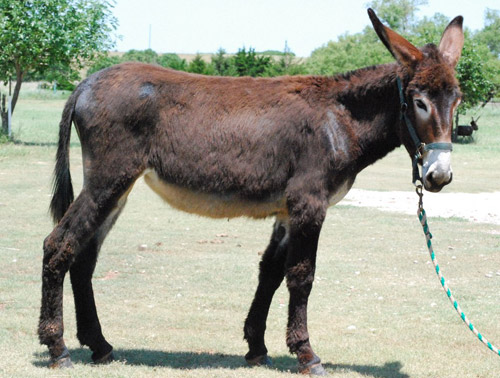
Intro
The world’s largest breed of ass, the American Mammoth Jack stock was developed in the U.S. through the selective cross breeding of imported European stock with local Native American and Mexican animals.
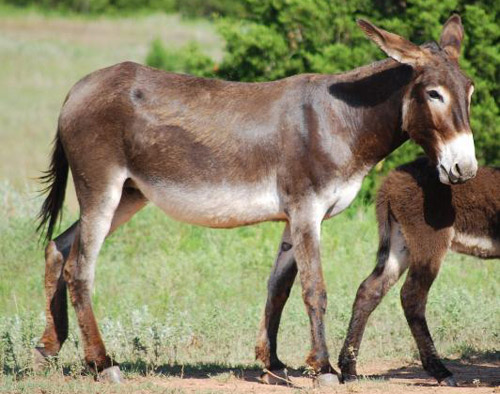
Origins
Small time breeding of these animals was done for more than 100 years prior to the development of an official registry in 1888.
This is an animal developed based on the needs of people in various areas, but mainly for agricultural & transportation needs. The intention was to create a larger & stronger animal more capable of heavy workloads.
Selective breeding helped to preserve important traits, but was often limited to what was available to use. However initially the registry attempted to standardize the breed to only include black animals a minimum of 15hands tall.
Over the years, these this rigid type lines have blurred and the breed encompasses a number of types.
Features
Jacks must be a minimum of 14.2 hands
Jennets must be a minimum of 14 hands
Incredibly strong
Jennets must be a minimum of 14 hands
Incredibly strong
Physique
Head is well shaped & tapered to a round muzzle
Large, wide-set eyes & long, upright ears
Neck should be muscular but not too thick & well proportioned
Good width, depth & length of body
Strong loins & a full hip
Legs should be strong and thick
Feet are large & well cupped
Large, wide-set eyes & long, upright ears
Neck should be muscular but not too thick & well proportioned
Good width, depth & length of body
Strong loins & a full hip
Legs should be strong and thick
Feet are large & well cupped
Traditional Colors
Initially they were to be black with a mealy / pangare gene however cross breeding has created more colors including sorrel.
Temperament
Willing and tireless
Mild mannered and kind
Mild mannered and kind
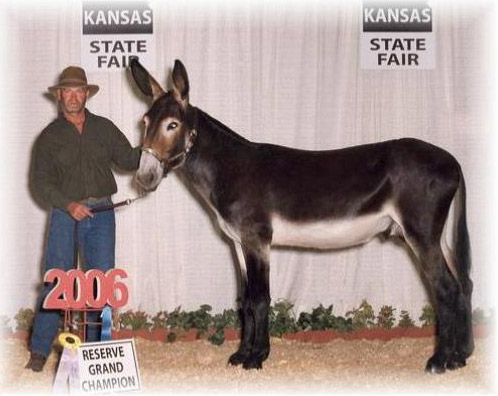
Use
Create draft mules
Recreational use
Agricultural work
Pleasure mount
Recreational use
Agricultural work
Pleasure mount
Helpful Links
*All links open in a new window
American Mammoth Jackstock Registry
American Livestock Breeds Conservancy
American Mammoth Jackstock Registry
American Livestock Breeds Conservancy
Where to Buy
American Mammoth Jack Studs
Video
American Indian Horse

Intro
Also known as cow pony, buffalo horse, mustang, Indian pony, cayuse and Spanish pony, these horses are descendants of the animals the Spanish conquistadors brought to the Americas that were adopted by the indigenous people.
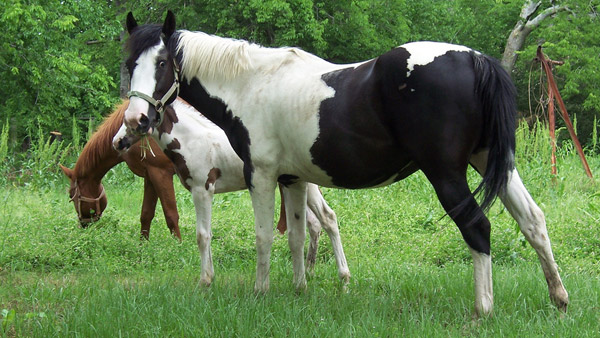
Origins
The American Indian Horse Registry (AIHR) was established in 1961 to preserve and document the pedigrees of Native American horses in the hopes of preserving the bloodlines.
The AIHR acknowledges 5 classifications of American Indian Horse
Class O
Not bred to conform to standards, but to preserve original bloodlines
Any horse registered since 1979 has direct bloodline connections to one of various tribes
Can be registered with Spanish Mustang Registry & Southwest Spanish Mustang Association
Not bred to conform to standards, but to preserve original bloodlines
Any horse registered since 1979 has direct bloodline connections to one of various tribes
Can be registered with Spanish Mustang Registry & Southwest Spanish Mustang Association
Class AA
Must have at least one Class O parent
Some BLM horses qualify for this classification
Must have at least one Class O parent
Some BLM horses qualify for this classification
Class A
Have unknown pedigrees
BLM horses qualify under this classification
Have unknown pedigrees
BLM horses qualify under this classification
Class M
Include modern bloodlines
One parent may be registered under another breed registry
Include modern bloodlines
One parent may be registered under another breed registry
Class P
For ponies of indian horse type
Galiceno, POA, Welsh and Shetland blood may be in their pedigrees
Also includes ponies of unknown ancestry
For ponies of indian horse type
Galiceno, POA, Welsh and Shetland blood may be in their pedigrees
Also includes ponies of unknown ancestry
Features
Average height 13 – 15 hands
Physique
Because the bloodlines are diluted and breeding for bloodlines is more important than confirmation this breed will vary physically.
Traditional Colors
All colors
Temperament
Temperament varies depending upon bloodlines.
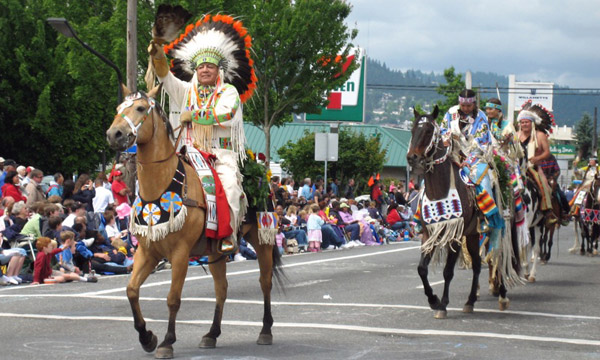
Use
Cow horses
Riding horses
Show horses
Agriculture animals
Riding horses
Show horses
Agriculture animals
Helpful Links
*All links open in a new window
American Indian Horse Registry
American Indian Horse Registry
Video
American Drum Horse
Intro
The drum horse makes a great heavy riding horse that has proven to be both a versatile and athletic mount. They are a relatively new breed to the US, but they have a rather distinguished history.
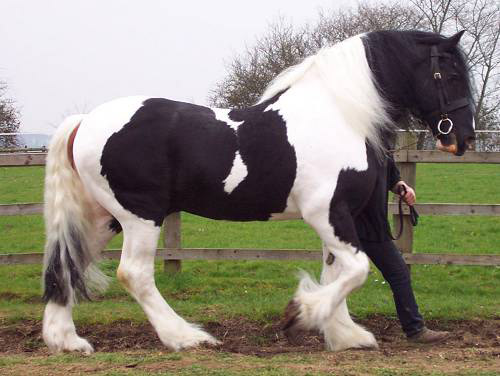
Origins
Drum horses were originally used by the Queen of England for her ceremonial band. The animals had to be large and sturdy enough to carry large kettle drums during any type of pageantry.
This meant that they were required to carry a great deal of weight through crowds of people. The mounted drummers needed their hands free to play, so they controlled their animals via reins attached to their stirrups.
The drum is an elegant heavy horse breed that utilizes the finest examples of theshire, clydesdale and gypsy cob breeds.
In the US the drum horses are favored more as riding & competition horses, both mounted and driving. They make sturdy, athletic mounts with a level head.
Features
Average height 16 hands and larger
Strong and forward movement
Gaits well balanced and even
Strong and forward movement
Gaits well balanced and even
Physique
Head attractive and well-proportioned
Eyes expressive and kind
Both convex and concave profiles acceptable
Neck is long and well muscled
Mane is abundant
Chest is deep and broad
Barrel is well-rounded with long well-set ribs
Legs straight and clean
Hooves are large with open heels
Feathering is required of the breed and should begin above the fetlock joint and cover the hoof
Eyes expressive and kind
Both convex and concave profiles acceptable
Neck is long and well muscled
Mane is abundant
Chest is deep and broad
Barrel is well-rounded with long well-set ribs
Legs straight and clean
Hooves are large with open heels
Feathering is required of the breed and should begin above the fetlock joint and cover the hoof
Traditional Colors
All colors
Temperament
Good character
Willing & sensible partner
Athletic and bold
Willing & sensible partner
Athletic and bold
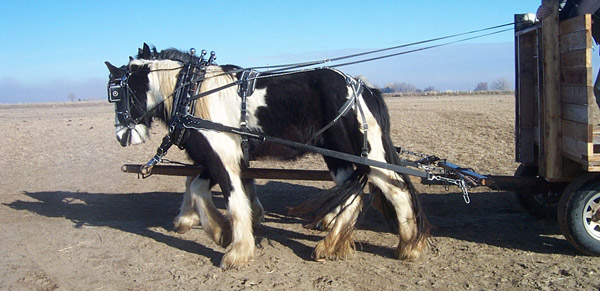
Use
General riding horse
Agriculture work
Showhorse
Agriculture work
Showhorse
Helpful Links
*All links open in a new window
American Drum Horse Association
Gypsy Drum Horses
American Drum Horse Association
Gypsy Drum Horses
Where to Buy
American Drum Studs
Video
American Cream Draft
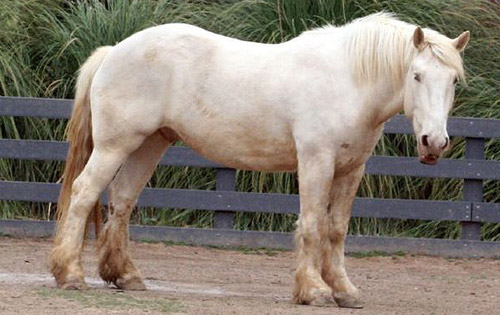
Intro
A relatively new breed, the American Cream Draft comes from Iowa in 1905 and a foundation mare named Old Granny.
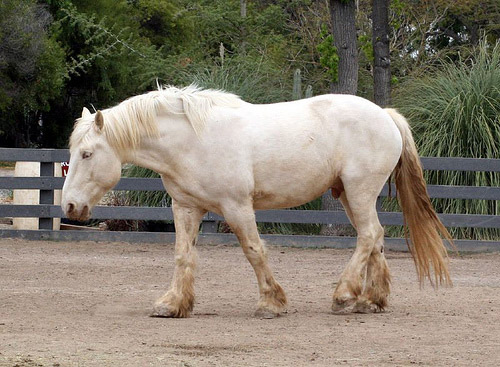
Origins
The only draft breed native to the US, the American Cream Draft is a rare breed with a cream coat, pink skin and amber colored eyes, all three specific traits of thechampagne dilution gene.
The American Cream Horse Association of America was developed in 1944 and the breed was recognized in 1950 by the Iowa Department of Agriculture. The flagship mare was bred to a number of different draft breeds and colors in the hopes of maintaining the creamy color.
The replacement of farm animals with heavy equipment caused a sharp decline in the cream numbers and the breed faced extinction. In 1982 a revival attempt was made and today the numbers still increase.
Features
Average height 15 – 16.3 hands
Medium-heavy draft type
Medium-heavy draft type
Physique
Head is refined with a flat or concave profile
Eyes are wide set and expressive
Well muscled shoulders
Rounded hindquarter and large barrel
Eyes are wide set and expressive
Well muscled shoulders
Rounded hindquarter and large barrel
Traditional Colors
Creme color comes from the champagne dilution gene
Temperament
Calm and quiet demeanor
Easy to train and eager to please
Strong and able
Easy to train and eager to please
Strong and able
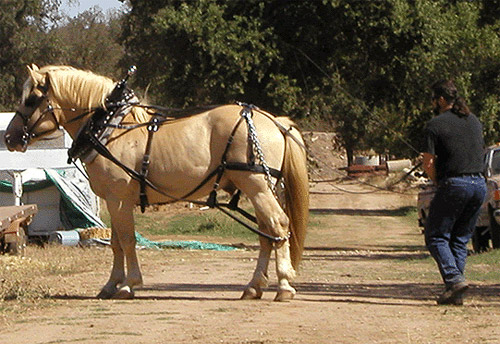
Use
Driving
Agriculture work
Show horses
Riding horses
Agriculture work
Show horses
Riding horses
Helpful Links
*All links open in a new window
American Cream Draft Horse Association
American Cream Draft Horse Association
Where to Buy
American Cream Draft Studs
Video
American Bashkir
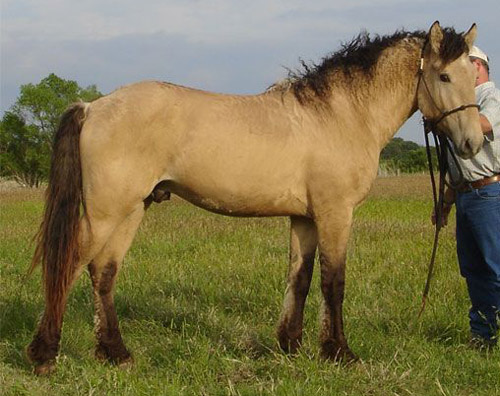
Intro
American Bashkir horses are the only breed found to be hypoallergenic, those allergic to horse dander do not have a reaction to these animals.
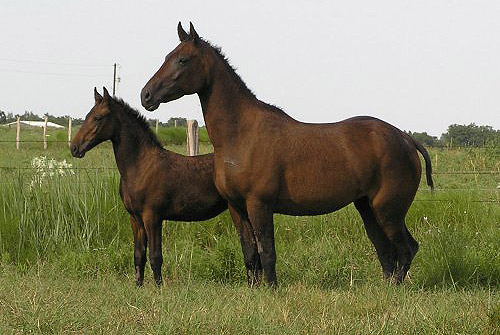
Origins
The origin of this breed is shrouded in mystery, which has caused debate as to whether or not “Bashkir” should be part of the official name of the breed. The existence of an horse with the curly gene is a mystery on North America. Their roots are obviously of the Bashkir horse from the steppes of the Ural mountains, however they were discovered in America early in the 19th century.
When minimally expressed curls may only appear in the ears, on fetlocks and in the mane and tail. When maximally expressed the horse displays curls all over, dreadlocks in its mane and curled eyelashes.
Mane and tail can completely shed out in the summer only to re-grow again with their winter coat.
Features
Average height 13.3 – 16 hands
Curly hair characteristics
Body hair should be fine and soft
Comes in many variations
Those allergic to horses can enjoy the curly horse
Curly hair characteristics
Body hair should be fine and soft
Comes in many variations
Those allergic to horses can enjoy the curly horse
Physique
Medium sized head, wide set eyes and curled up eyelashes
Neck is medium in length, deep at the base
Back is short and deep in the girth
Heavy boned legs
Hooves are very hard and dense
Coat is fine and soft with ringlets, a soft marcel wave or crushed velvet curls
Mane is kinky or wavy
Tail is in ringlets or wavy
Neck is medium in length, deep at the base
Back is short and deep in the girth
Heavy boned legs
Hooves are very hard and dense
Coat is fine and soft with ringlets, a soft marcel wave or crushed velvet curls
Mane is kinky or wavy
Tail is in ringlets or wavy
Traditional Colors
All colors
Temperament
Even-tempered and strong

Use
Pleasure horses
Show horses
Ranch horses
Show horses
Ranch horses
Helpful Links
*All links open in a new window
American Bashkir Curly Horse Registry
Curly Sporthorse International
International Curly Horse Organization
Curly Horse Pedigree Database
Curly Horse Country
American Bashkir Curly Horse Registry
Curly Sporthorse International
International Curly Horse Organization
Curly Horse Pedigree Database
Curly Horse Country
Where to Buy
American Bashkir Studs
Video
American Albino

Intro
The albino gene is fatal to horses, a pure albino is a result of lethal white genes from both parents and will always die in the womb. American Albino (also called American Cream & White) horses are pure white, but not actually albino genetically.
Origins
The American Albino is a color which has been given registry as a breed in the U.S., started to recognize the offspring of a white stallion named Old King. He had a record of producing white foals out of solid-colored mares.
The ancestry of Old King is not known, but he was thought to have been of Arabian /Morgan descent due to confirmation similarities. He was initially bred to Morgan mares and in 1936 the American Albino registry was created to track his bloodlines and breeding records.
In 1937 the American Albino Horse Club (now called the American White & American Creme Horse Registry) was formed and their sole object was to preserve the pedigrees and promote interest for the different types of American Albino horses.
Features
Average height 15 hands
Pink skin and pure white hair
Can exist in almost all breeds of horse
Pink skin and pure white hair
Can exist in almost all breeds of horse
Physique
Will vary depending on the breed
Stunning white coat
Stunning white coat
Traditional Colors
Only white
Temperament
Intelligent
Excellent disposition
Willing
Excellent disposition
Willing
Use
Can be found in almost any discipline.
American Warmblood
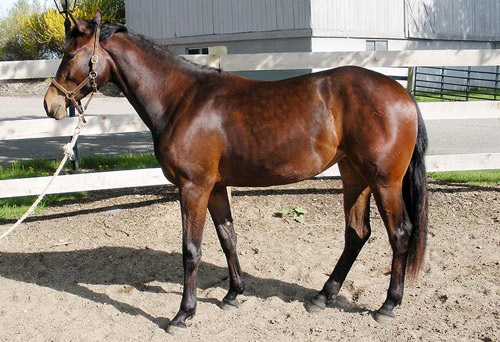
Intro
Many different bloodlines may be registered as American Warmblood horses, they are required to be of sport horse or warmblood type and meet studbook requirements.

Origins
There are two registries who recognize American Warmbloods, the American Warmblood Society and the American Warmblood Registry and both are recognized by the World Breeding Federation for Sport Horses.
Horses are registered on the basis of type rather than preserving bloodlines, the goal is to continue breeding superior sport horses.
Features
Average height 15 – 17 hands
Powerful & balanced with elastic gaits
Powerful & balanced with elastic gaits
Physique
Varies due to the number of bloodlines allowed to register
Traditional Colors
All colors – solid colors most common
Temperament
Well-mannered and attentive
Tractable and willing
Focused and calm
Tractable and willing
Focused and calm
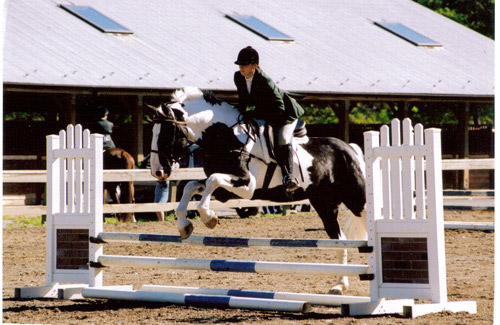
Use
Show horse
Eventing horse
Show jumper
Eventing horse
Show jumper
Helpful Links
*All links open in a new window
American Warmblood Registry
American Warmblood Society
World Breeding Federation for Sport Horses
American Warmblood Registry
American Warmblood Society
World Breeding Federation for Sport Horses
Where to Buy
Video
American Walking Pony
Intro
American Walking Pony Registry was founded in 1968 and started with experimental breeding to develop an Arabian type pony with smooth saddle gaits.
Origins
This breed originated with a Tennessee Walking Horse / Welsh pony cross, to create a lovely animal with gliding gaits.
The seven-gaits of this pony are inherited and the Welsh influence makes them good hunters.
Features
Average height 14 hands
Light, flowing action
Light, flowing action
Physique
Small, neatly chiseled head
Eyes are bold and set wide apart
Ears are well-shaped and pointed
Neck is long, arched and high-set
Back is short
Long and sloping shoulders & deep girth
Eyes are bold and set wide apart
Ears are well-shaped and pointed
Neck is long, arched and high-set
Back is short
Long and sloping shoulders & deep girth
Traditional Colors
Solid colors
Temperament
Calm and willing
Use
Cart pony
Show pony
Sport pony
Pleasure pony
Show pony
Sport pony
Pleasure pony







fantastic site !
ReplyDeleteI Loved reading about these horses. I found out so much. congratz keep it up!